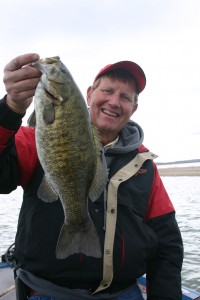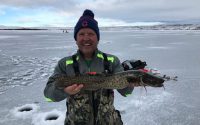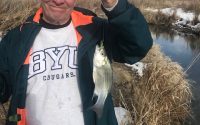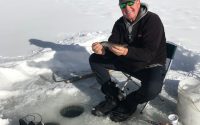The Postspawn!

For years I have swapped horror stories with the pros, personally experienced, and have written about the difficulty in catching postspawn bass: those several days to a couple of weeks immediately after the spawn that fish don’t want to bite. The real frustration is that with limited time to be on the water, the advance planning necessary to schedule vacations and even tournaments, coupled with just plain impatience, there are times that postspawn or not, we all need or want to catch fish. So, let’s once and for all tackle the postspawn funk.
In the early prespawn period, the bass are hungry and feed aggressively. Then, they settle into the prespawn/spawn mode which means they eat less and are all about nest building, and getting ready. Bass are relatively easy to catch during this period because they react to lures that pass close to their intended nesting sites.
Then, they occupy their nests and spawn. Bed fishing can be exciting and frustrating at the same time. Once the spawn concludes, the females drift away from the nest and recover from their ordeal. The males stay and protect the nest for a while and then, they too abandon the area. It is this period of recovery from the spawn that we struggle to catch fish. The females don’t eat for a few days until they regain their strength.
Everything I just wrote is accurate, however it is simply not reality, plain and simple.
John Murray, an Elite Angler for B.A.S.S. from Mesa, Arizona described how the spawn really works, at least in large and diverse Western waters. “Take Lake Powell for example,” he said. “The spawn lasts from March through June in some years. That’s close to four months of spawning activity. That means that during that period, depending on where you’re fishing, you could be targeting all three phases of the spawn at the same time.”
Reality check number one: All the bass in a lake DO NOT spawn at once! I don’t care what you’ve read or what I’ve written about moon cycles and spawning behavior. It seems we all get caught up at times with the thought that all bass behave the same. So, if we’re not catching fish at one specific time or another, we look to place blame somewhere. So, it becomes very easy during the postspawn period to simply blame our lack of bites on Mother Nature.
“Bass prepare for the spawn as winter ends and the water temperature rises above 50 degrees,” continued Murray. “But certain areas of Lake Powell heat up a lot earlier than others. Protected bays with a lot of shallow water that don’t get direct wind day in and day out warm up first. As the sun stays up longer and longer each day as spring sets in, those bays warm up and preparations for the spawn get a jump start.”
Murray’s comments beg the question, “Isn’t all the water in a lake roughly the same temperature?” And Murray’s answer is a resounding NO. “The backs of bays and the backs of deep dark canyons warm first,” he said. ” Then the middle areas, not exactly in the main channel of the lake but not in the backs either tend to warm next. This is followed by the main channel. Areas in the main channel might be months behind other areas in the lake.”
Reality check number two: All bass are NOT going through the postspawn period at the same time. I learned this first-hand recently when I did very well in a tournament on Lake Powell by targeting prespawn, spawn, and postspawn fish on the same day. I built a “milk run” of five areas that I fished twice in my eight-hour tournament day. Two of the areas had bass on beds. Two areas were in heavily stained water and I couldn’t see beds but assumed they were there. And, one area (in crystal clear water) revealed many beds being protected by aggressive little males that wouldn’t help my bag of fish, but were obviously waiting for the eggs to hatch. Normally, I would avoid the small males but because the area was in such clear water, I could see large, postspawn females lounging about in cruise mode in 10- to 15 feet of water. I caught several of those postspawn females by casting a weightless Senko to them from a good distance, allowing the recovering bass to “find” me rather than the other way around.
Reality check number three: While throwing Senkos at those large postspawn females, I caught several prespawn females and large males getting ready to move up and spawn! What a novel thought. So, if I were fishing in a bath tub and only had a few postspawn fish to target, I may have needed dynamite to catch a few fish. But, when I got my head around the fact that only postspawn fish were going to be difficult to catch and that other fish besides the postspawn females also shared the water, my attitude changed and I continued catching quality fish throughout both tournament days.
Reality check number four: Many bass don’t even spawn each year. Though there are many conflicting studies out there, I believe it would be safe to say that less than 30 percent of bass in a given body of water will spawn in a given year. There are many reasons for this, but suffice it to say that weather, water levels, and bass anatomy all affect whether or not bass spawn.
The easiest and best way to catch postspawn bass then is NOT to target them, plain and simple. The pros like to throw Senkos, floating worms, suspending jerkbaits, and even dropshot worms to postspawn bass. And at times all of those baits are reasonably effective. But those baits will catch all bass. If you are fishing areas that hold good numbers of fish, create in your mind the idea that you are NOT fishing for postspawn fish: that you’re fishing for non-spawning, or prespawning, or summer patterning fish (fish beyond the postspawn period). This way, when you aren’t catching fish you’ll experiment, change baits, slow down, speed up, or make other changes that you would make at other times in the year when you struggle to catch fish.
The postspawn period should not frustrate you. Simply target other fish and you will marvel at not only how many fish you do catch but you’ll also be surprised as to how many postspawn fish are among your catch. This is the reality of fishing after the spawn.










